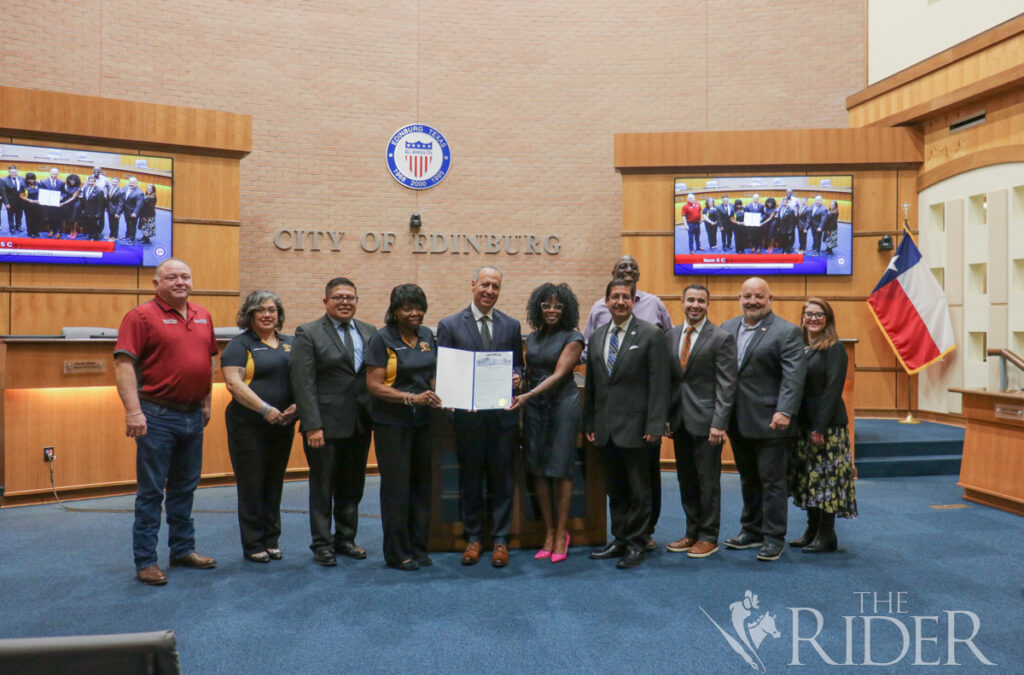
The Edinburg Consolidated Independent School District is pushing for legislative change to remove South Texas Independent’s School District’s taxing authority and use “existing funding models to equalize per-student funding.”
During the Feb. 7 Edinburg City Council meeting, ECISD Superintendent Mario Salinas provided a presentation on the differences in funding between ECISD and STISD.
“[STISD] provides one of the educational services to our community, so it is not about disparaging the school,” Salinas said. “It’s about presenting the facts.”
The first of two desired legislative changes is the removal of “taxing authority for South Texas ISD based on voter approval from each independent school district across the three-county area,” according to the presentation. This would decrease the amount of taxes property owners pay in Hidalgo, Cameron and Willacy counties.
The second change requested is to “utilize existing funding models to equalize per-student funding to mirror average funding amounts per student found in Region One,” according to the presentation.
In an interview with The Rider last Wednesday, Amanda Odom, STISD administrator for Public Relations & Marketing, said public school districts in “South Texas are forming a coordinated effort to support or promote potential legislation that would eliminate South Texas ISD taxing authority, thereby effectively eliminating South Texas ISD.”
Odom also said the information provided on the ECISD presentation is not accurate, such as the lack of an Interest & Sinking rate. The I&S rate is a tax that provides funds “for payments on the debt that finances a district’s facilities,” according to the Texas Education Agency’s website.
Odom said STISD is working on providing the correct data.
South Texas ISD was created 60 years ago in response to the lack of services for students in special education by ECISD and other Rio Grande Valley school districts, Salinas said during his presentation. The Texas Legislature allowed STISD the authority to tax five cents per $100 valuation.
However, Salinas said STISD no longer follows its original mission but its taxing authority remains. He said the district serves few students with special needs and only provides services for half a school day.
The enrollment average for students with special needs is 10.3% for all three counties. Of STISD’s 4,251 students, 3.88% receive special education. Meanwhile, 11% of ECISD’s 34,000 students receive special education.
“Over time, changes in legislation mandated that students with special needs be mainstreamed and served in their home districts,” Odom explained.
Salinas said some residents of Hidalgo, Cameron and Willacy counties may be required to pay property taxes for two school districts. This means that even if a family does not have a child enrolled in STISD, they may still have to pay a property tax for the school.
Salinas said it is ironic that STISD continues to levy a tax rate of five cents per $100 on property owners in the Valley, who he said are among the poorest in the state.
As of the 2021-22 school year, ECISD’s tax collection per student was $2,543.52, totaling $84,301,889. By comparison, STISD has 700 Edinburg city students enrolled, and the average tax collection per student is $6,000, totaling $4,200,000.
“We think that’s inequitable when you compare South Texas ISD to all the other independent school districts,” Salinas said.
He also said there is a gap between how much each district receives from the government. ECISD obtains $7,457.70 per student from government funding while STISD schools obtain $12,611.87, according to Salinas.
“This year, property values went up more, $2.1 billion in Edinburg,” he said. “We were forced to reduce our tax rate to the taxpayer, almost five pennies. We lost $4 million, almost $5 million. [STISD is] not subject to that.
“They just keep getting more and more. They’re not subject to what they call compression, bringing down your tax rate. Like, we brought the tax rate [down by] over eight pennies in the last two years to save the taxpayers of Edinburg money.”
Salinas emphasized that STISD does not provide any additional services than what ECISD already offers.
Odom said the total revenue that STISD receives is actually much less compared to other school districts that have access to other sources of revenue that it does not.
“The main argument, you know, by these efforts is that they claim that there’s a duplication of taxes for the residents in the three counties,” she said. “So our tax rate is .0492 cents, so we are capped at a nickel per $100 valuation. Other school districts are over $1 per $100 valuation, so our district would cost the average homeowner approximately $5.33 per month.”
Based on the Hidalgo County Tax Office 2022 tax rate schedule, the ECISD tax rate per $100 value is $1.0604.
In the Valley, 84% of children are considered economically disadvantaged, according to the Texas Education Agency’s Public Education Information Management System. In ECISD, 81.7% of the students are considered “poor,” compared with 51% of STISD students.
“This school is an elite school when you consider the wealth of that student population,” Salinas said. “They don’t need those five extra pennies.”
The Texas Education Agency has funding mechanisms that STISD can use instead, and which will bring an equity of funding to both districts without extra taxes being collected, he said.
In an interview with The Rider Tuesday night, Salinas said that removing STISD’s taxing authority will not “kill the school.”
“They’re simply gonna have to survive with the same funding that everybody else gets,” he said.
However, Odom told The Rider in response to Salinas’ statement that “without the tax revenue, we would not be able to service the three counties that we serve.”
Edinburg Place 2 Councilmember Jason De Leon asked Salinas why the concern was just brought up to the council and the community.
Salinas replied that he was just informed about this two and a half months ago during a superintendents meeting, which STISD Superintendent Marco A. Lara Jr. also attended.





